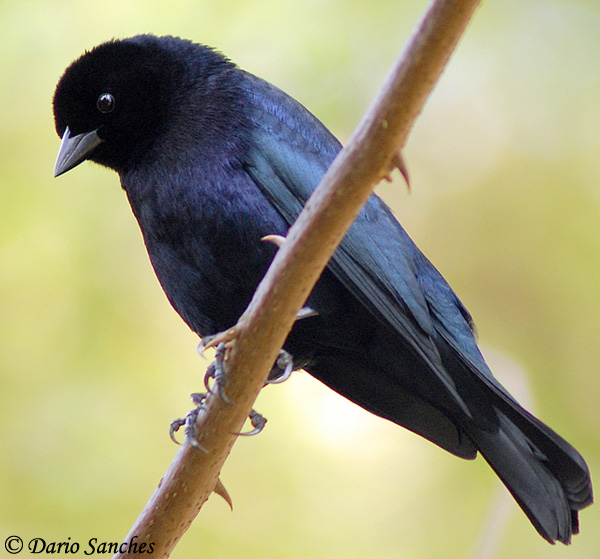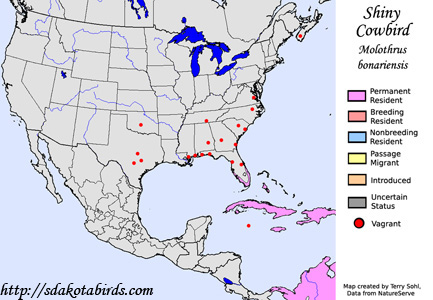| Length: 7.5 inches | Wingspan: 11 inches | Seasonality: Non-resident in South Dakota |
| ID Keys: Males glossy black overall. Females a warm brown and plain. | ||
 The
Shiny Cowbird is a very recent arrival to North America. They first
spread from South America to the Caribbean, quickly expanding their range
and occupying many Caribbean islands. The first time a Shiny Cowbird
was seen in the United States was 1985, when a lone male was found in
Florida. Since then, they have become permanent breeding residents in
Florida. They have also been found in widely scattered locations in
the U.S. since 1985, from Maine to Texas. It is thought that removal of
forests on Caribbean islands aided the spread of the species, given that
they strongly prefer open habitats.
The
Shiny Cowbird is a very recent arrival to North America. They first
spread from South America to the Caribbean, quickly expanding their range
and occupying many Caribbean islands. The first time a Shiny Cowbird
was seen in the United States was 1985, when a lone male was found in
Florida. Since then, they have become permanent breeding residents in
Florida. They have also been found in widely scattered locations in
the U.S. since 1985, from Maine to Texas. It is thought that removal of
forests on Caribbean islands aided the spread of the species, given that
they strongly prefer open habitats.
Habitat: Found in a variety of open habitats in the U.S. mostly near the coastline. In the core of their tropical range, they are found in nearly any kind of open or semi-open habitat.
Diet: Feeds on both insects and seeds, with diet dependent upon season and location.
Behavior: Forages by walking on the ground in open habitats, usually in small groups, often mixed with other blackbird species.
Nesting: The Shiny Cowbird is a brood parasite, like other cowbird species. The female will lay eggs in the nests of many other species, and typically will puncture the eggs of the host species.
Song: The song of a Shiny Cowbird is a series of high-pitched, squeaky notes that accelerates and descends in pitch before ending with one to three kwit notes.
Migration: In the tropics, Shiny Cowbirds are mostly considered permanent residents. Most in North America are also likely permanent residents, but given the short time the species has been found here, migration patterns are poorly understood. There are some indications that some birds move from the Caribbean to southern Florida in the spring. Birds in the northern part of their U.S. range may also move southward in the fall.
Interactive eBird map: Click here to access an interactive eBird map of Shiny Cowbird sightings
Similar Species: Similar to Brown-headed Cowbird, Bronzed Cowbird
Feeders: Will attend feeders for various seeds.
Conservation Status: Populations of the Shiny Cowbird are increasing, and they are expanding in range. The IUCN lists the Shiny Cowbird as a species of "Least Concern".
Further Information: 1) WhatBird - Shiny Cowbird
2) North American Invasion Pattern of the Shiny Cowbird
3) Cornell's All About Birds - Shiny Cowbird
Photo Information: Photo taken by Dario Sanches - August 31st, 2007 - Jardim Botanico de Sao Paulo - Photo licensed under Creative Commons Attribution ShareAlike 2.0 Generic License.
| Click below for a higher-resolution map |
 |
| South Dakota Status: Non-resident in South Dakota |
Additional Shiny Cowbird Photos (coming soon!!)
